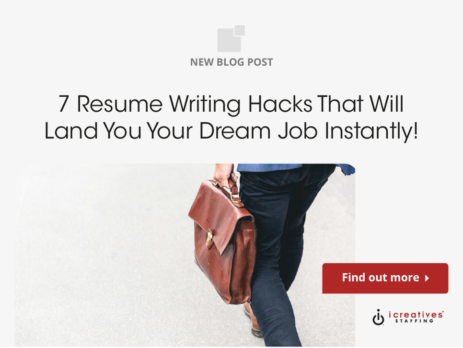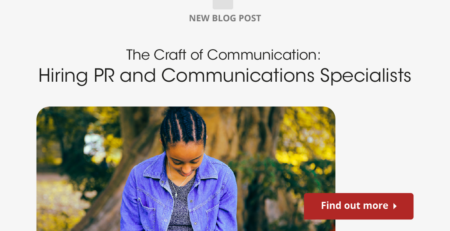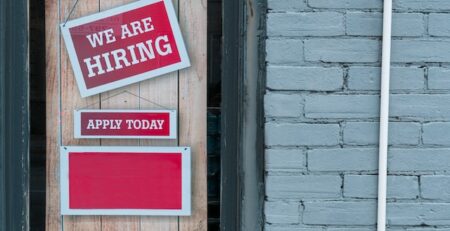7 Resume Writing Hacks That Will Land You Your Dream Job Instantly!
In today’s competitive job market, standing out from the crowd is more crucial than ever. Crafting a resume that catches the eye of hiring managers can be the key to unlocking job opportunities. However, many job seekers struggle with knowing what exactly makes a resume effective. This guide explores seven resume writing hacks that can dramatically increase your chances of landing your dream job instantly. From leveraging strategic keywords to formatting tips that enhance readability, these insights are designed to give you an edge over the competition.
The importance of a well-written resume cannot be overstated. It is not just a list of your past experiences and skills; it is a marketing tool that must sell your professional capabilities to potential employers. Each section of your resume should be thoughtfully crafted to highlight your strengths and align with the job you are applying for. By implementing these hacks, you can create a compelling narrative that demonstrates your value and potential impact.
One of the key aspects of a successful resume is its ability to pass through Applicant Tracking Systems (ATS) which many companies use to screen candidates. Understanding how these systems work and how to optimize your resume for them can significantly increase your chances of getting noticed. Another critical element is the visual presentation of your resume. A clean, professional layout can make a significant difference in how your information is perceived.
Moreover, tailoring your resume for each job application is essential. This involves more than just changing the company name in your objective statement; it requires a deep understanding of the job description and the company culture. This tailored approach ensures that your resume speaks directly to the hiring manager’s needs and increases your relevance for the position.
By the end of this guide, you will be equipped with practical tips and strategies to enhance your resume. Whether you’re a seasoned professional or a recent graduate, these hacks will help you craft a resume that not only looks great but also resonates with recruiters, paving the way for job interview invitations and, ultimately, your ideal job placement.
Most Asked Questions About Resume Writing Hacks
- How can I optimize my resume for Applicant Tracking Systems (ATS)?
- What are the best practices for formatting my resume?
- How should I tailor my resume for different job applications?
- What key elements should every resume include?
- How can I effectively use keywords in my resume?
Optimizing Your Resume for Applicant Tracking Systems (ATS)
Applicant Tracking Systems (ATS) are used by many employers to screen resumes before they ever reach human eyes. An ATS can make or break your job application depending on how well your resume is optimized for this technology. The first step in ATS optimization is understanding that these systems are designed to scan for specific keywords and phrases that are relevant to the job posting.
To enhance your resume’s ATS compatibility, start by carefully reading the job description. Identify the skills, experiences, and qualifications that are mentioned most frequently. These are likely the keywords that the ATS will be programmed to seek. Incorporate these keywords naturally throughout your resume, particularly in the ‘Skills’ and ‘Experience’ sections.
Another crucial aspect of ATS optimization is the structure of your resume. Many ATS systems struggle with unusual formatting. Stick to a simple, clean layout with clear headings and a standard font. Avoid using headers or footers as the information placed there might not be scanned by the ATS. Similarly, use standard resume headings like ‘Work Experience’, ‘Education’, and ‘Skills’ to ensure the ATS can easily categorize the information.
It’s also advisable to submit your resume in the right file format. A PDF file might preserve your formatting, but some ATS systems read Word documents (.doc or .docx) more effectively. Check the job listing or with HR to see if a preferred format is mentioned. If in doubt, consider submitting both formats to cover all bases.
Lastly, don’t overstuff your resume with keywords. While it’s important to include relevant keywords, the ATS is also calibrated to assess the context in which each keyword is used. Your resume should still read naturally and clearly convey your professional experiences and achievements. Overusing keywords can make your resume read awkwardly and could flag it as potential spam to the ATS.
For more insights on navigating the job application process, consider reading about mastering job interviews.

Best Practices for Formatting Your Resume
The layout and design of your resume play a pivotal role in its readability and overall impression. The goal of effective formatting is to make your resume as easy to read as possible for hiring managers. Start with choosing the right font. Professional fonts like Arial, Calibri, or Times New Roman are best as they are easy on the eyes and ensure that your resume appears polished and readable.
When it comes to font size, keep the body text between 10-12 points. Your name and section headings can be slightly larger to draw attention. Consistency in your font size and style throughout the document is key to maintaining a clean look. Additionally, use bold and italic typefaces sparingly to highlight important information without overwhelming the reader.
Margins are another important aspect of your resume’s layout. Typically, margins should be set at one inch on all sides, providing a balanced amount of white space around the text. This not only makes your resume more attractive but also more readable. White space is crucial as it helps prevent the document from appearing cluttered.
Bullet points are effective for breaking up dense blocks of text and drawing attention to your most relevant accomplishments. Each bullet point should start with a strong action verb to convey your contributions clearly. Limit the number of bullet points per job to no more than six to avoid overwhelming the reader with information.
Finally, the length of your resume is also a critical consideration. For most professionals, a one-page resume is sufficient, especially if you have less than 10 years of experience. If you have a longer career history, a two-page resume is acceptable, but be sure to fill both pages adequately. The key is to include only the most relevant and recent experiences that align with the job you are applying for.
Understanding the nuances of resume formatting can significantly enhance your job application. For further reading on avoiding common mistakes, check out mistakes web designers make when job hunting.
Tailoring Your Resume for Different Job Applications
One size does not fit all when it comes to resumes. Tailoring your resume for each job application is crucial in highlighting your qualifications that are most relevant to the position. Start by analyzing the job description. Identify the skills and experiences that are emphasized and make sure these are reflected in your resume.
Adjust your professional summary to align with the tone and requirements of the job you are applying for. This section should be a pitch that shows why you are a perfect fit for the job. Use the same job title and some of the industry-specific keywords found in the job description to make this section as relevant as possible.
Your work experience should also be tailored. Rather than listing every duty you’ve ever had, focus on specific responsibilities and achievements that match the qualifications requested in the job description. Use numbers and statistics to quantify your achievements and demonstrate the impact of your work.
Education and certifications should be included especially if they are requirements or desirable qualifications for the job. If you have many certifications, include only those most relevant to avoid cluttering your resume. For recent graduates, education can be placed above the work experience section to highlight academic accomplishments.
Don’t overlook the importance of soft skills. Many employers value interpersonal and organizational skills as much as technical abilities. Highlight these skills within the context of your work experience to show how they translate into real-world capabilities.
Finally, a cover letter can be a valuable tool in tailoring your application. It allows you to discuss your qualifications in a more narrative form and show how your goals align with those of the company. Always include a personalized cover letter with each resume submission, unless specifically instructed not to do so.
For more tips on enhancing your job application, explore transforming your marketing with freelance creatives.

Key Elements Every Resume Should Include
Every effective resume includes several key elements that present the candidate’s qualifications in a clear and concise manner. The contact information section is crucial and should be prominently placed at the top of the resume. Include your full name, phone number, professional email address, and LinkedIn profile URL if applicable. Ensure this information is accurate and up-to-date to avoid missing potential job opportunities.
The professional summary or objective statement gives you an opportunity to capture the hiring manager’s attention. Tailor this section to reflect the essence of what you bring to the table, focusing on your key achievements and the skills that make you a perfect fit for the role.
Work experience is the heart of your resume. List your previous positions in reverse chronological order, starting with the most recent. For each position, provide your job title, the company’s name, location, and the dates of employment. Under each role, use bullet points to describe your responsibilities and achievements, focusing on those that align with the job you’re applying for.
Your educational background should also be included, listing the degrees you have earned, along with the institutions you attended and graduation dates. If you have higher education or relevant certifications, these should be highlighted as they can make you a more attractive candidate.
Skills are increasingly important in resumes. Include a mix of hard and soft skills that are relevant to the job. Hard skills are job-specific abilities, while soft skills are more about how you work and interact with others. Tailor this section to match the skills mentioned in the job description as closely as possible.
Finally, consider adding additional sections that could be relevant, such as publications, projects, volunteer work, or professional affiliations. These can provide a fuller picture of your capabilities and interests, especially if they are relevant to the job you are applying for.
For additional insights into what employers are looking for, read about what American employers are looking for in your UX/UI portfolio.
Effectively Using Keywords in Your Resume
Using the right keywords in your resume is essential for two main reasons: passing the ATS and catching the eye of the hiring manager. Keywords are typically the skills, qualifications, and experiences that are directly related to the job position. To find the most effective keywords, start by thoroughly reading the job description. Highlight the terms that appear frequently or are emphasized by the employer.
Once you have a list of potential keywords, incorporate them into your resume strategically. Place them in your professional summary, skills section, and throughout your work experience descriptions. Make sure that the keywords fit naturally into sentences and maintain the flow of your narrative.
It’s important to use both acronyms and full names of certifications and technologies, as you don’t know if the ATS will recognize one or the other. For example, use both “SEO” and “Search Engine Optimization” within your resume to cover all bases.
Be specific with your skills and avoid vague terms. For instance, instead of saying “experienced in marketing,” specify what type of marketing you excel in, such as “digital marketing” or “content marketing.” This specificity can help your resume stand out more to both an ATS and a potential employer.
Also, remember to update your resume regularly to include new skills and experiences, especially those that are in high demand in your industry. This not only helps with ATS but also shows potential employers that you are continually learning and staying current in your field.
For those in creative fields, understanding the intersection of UX and UI design can be particularly relevant. Consider exploring how UX and UI work together for more insights.
Conclusion
Mastering the art of resume writing is a crucial step in advancing your career. The hacks discussed in this guide are designed to help you create a resume that not only passes the screening processes like ATS but also impresses hiring managers. Remember, a resume is more than just a document; it’s a tool to market yourself and your skills to potential employers.
By optimizing your resume for ATS, using effective formatting, tailoring it to specific job applications, including essential elements, and strategically using keywords, you can significantly increase your chances of landing your dream job. Each of these elements plays a crucial role in crafting a resume that stands out from the competition.
As the job market continues to evolve, so should your resume. Keep it updated with new skills, experiences, and achievements. Always tailor it for each new job application to reflect the specific needs and culture of the company you are applying to.
Finally, remember that your resume is just the first step. Prepare thoroughly for interviews and continue to build your professional skills and network. For more tips on navigating the job market, consider exploring additional resources such as hiring remote illustrators to boost your brand’s image and other insightful articles on our blog.
With these strategies, you are well on your way to making a great first impression and moving one step closer to your dream job. Good luck!
In today’s competitive market, finding the right creative and marketing expert can be a challenge. But with icreatives, you’re in experienced hands. With 37 years in staffing and a track record of matching more than 10,000 employees to over 1,000 companies worldwide, we know how to connect you with the best. Plus, you only pay if you hire—there’s no risk, only results.Ready to find your perfect creative or marketing expert? HIRE WITH ICREATIVES today!












